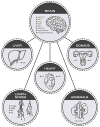Diagnostic Biomarkers for Posttraumatic Stress Disorder: Promising Horizons from Translational Neuroscience Research
- PMID: 25727177
- PMCID: PMC4520791
- DOI: 10.1016/j.biopsych.2015.01.005
Diagnostic Biomarkers for Posttraumatic Stress Disorder: Promising Horizons from Translational Neuroscience Research
Abstract
Posttraumatic stress disorder (PTSD) is a heterogeneous disorder that affects individuals exposed to trauma (e.g., combat, interpersonal violence, and natural disasters). Although its diagnostic features have been recently reclassified with the emergence of the Diagnostic and Statistical Manual for Mental Disorders, Fifth Edition, the disorder remains characterized by hyperarousal, intrusive reminders of the trauma, avoidance of trauma-related cues, and negative cognition and mood. This heterogeneity indicates the presence of multiple neurobiological mechanisms underlying the etiology and maintenance of PTSD. Translational research spanning the past few decades has revealed several potential avenues for the identification of diagnostic biomarkers for PTSD. These include, but are not limited to, monoaminergic transmitter systems, the hypothalamic-pituitary-adrenal axis, metabolic hormonal pathways, inflammatory mechanisms, psychophysiological reactivity, and neural circuits. The current review provides an update to the literature with regard to the most promising putative PTSD biomarkers, with specific emphasis on the interaction between neurobiological influences on disease risk and symptom progression. Such biomarkers will most likely be identified by multi-dimensional models derived from comprehensive descriptions of molecular, neurobiological, behavioral, and clinical phenotypes.
Keywords: Biomarkers; Inflammation; Neuroendocrinology; Neuroimaging; PTSD; Psychophysiology.
Copyright © 2015 Society of Biological Psychiatry. All rights reserved.
Figures

References
-
- Kessler RC, Sonnega A, Bromet E, Hughes M, Nelson CB. Posttraumatic stress disorder in the national comorbidity survey. Archives of General Psychiatry. 1995;52:1048–1060. - PubMed
-
- Breslau N. The epidemiology of posttraumatic stress disorder: what is the extent of the problem? J Clin Psychiatry. 2001;62(17):16–22. - PubMed
Publication types
MeSH terms
Substances
Grants and funding
LinkOut - more resources
Full Text Sources
Other Literature Sources
Medical
Miscellaneous

